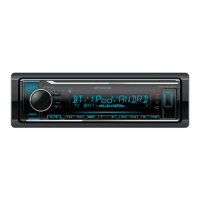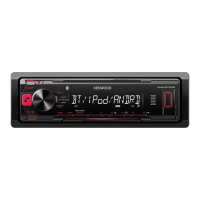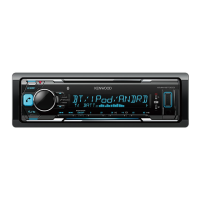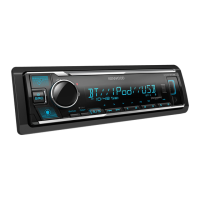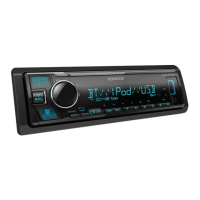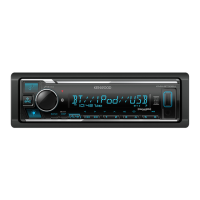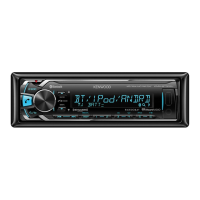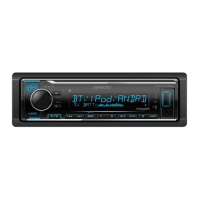Why is Alexa not responding on my Kenwood KMM-BT306 Receiver?
- KkevinwrightSep 15, 2025
If there is no response from Alexa after the voice input, it means that the Amazon cloud was unable to analyze the voice input.
Why is Alexa not responding on my Kenwood KMM-BT306 Receiver?
If there is no response from Alexa after the voice input, it means that the Amazon cloud was unable to analyze the voice input.
What does 'Unsupported Device' mean on my Kenwood KMM-BT306 Receiver?
If the message “UNSUPPORTED DEVICE” appears on your Kenwood Receiver, verify that the connected USB device is compatible with the unit and that the file systems are in a supported format. You can also try reattaching the USB device.
What does 'No Device' mean on my Kenwood Receiver?
If the message “NO DEVICE” appears on your Kenwood Receiver, connect a device (USB/iPod/iPhone) and change the source to USB or iPod USB again.
What does 'Disconnected' mean on my Kenwood KMM-BT306?
If the message “DISCONNECTED” appears on your Kenwood Receiver, the USB is disconnected from the head unit. Please ensure that the device is properly connected through USB.
Why is Alexa giving the wrong response on my Kenwood KMM-BT306?
If you're getting the wrong response from Alexa, it's possible that Alexa misunderstood what was said or didn't catch the entire request or sentence spoken. Please try again.
What does 'Switching NG' mean on my Kenwood KMM-BT306?
If the message “SWITCHING NG” appears on your Kenwood Receiver, the connected phones might not support the phone switching feature.
What does 'USB Hub is not Supported' mean on Kenwood KMM-BT306 Receiver?
If the message “USB HUB IS NOT SUPPORTED” appears on your Kenwood Receiver, this unit cannot support a USB device connected via a USB hub.
What does 'Copy Pro' mean on my Kenwood KMM-BT306 Receiver?
If the message “COPY PRO” appears on your Kenwood Receiver, a copy-protected file is being played from the USB device.
What does 'Unresponsive Device' mean on my Kenwood KMM-BT306?
If the message “UNRESPONSIVE DEVICE” appears on your Kenwood Receiver, ensure that the USB device is not malfunctioning and reattach it.
Why won't my Kenwood Receiver switch to USB source?
If the source doesn't change to “USB” when you connect a USB device while listening to another source, the USB port may be drawing more power than the design limit. Turn the power off and unplug the USB device. Then, turn the power back on and reattach the USB device. If the problem persists, turn the power off and on (or reset the unit) before trying a different USB device.
Steps for connecting a USB storage device.
Steps for connecting an Apple iPod or iPhone.
Steps to begin audio playback from an AUX device.
Using the KENWOOD Remote app for receiver control.
Step-by-step guide for pairing a new Bluetooth device.
Streaming audio from a Bluetooth device to the unit.
How to handle incoming phone calls.
How to make phone calls from the unit.
Streaming iPod/iPhone audio via Bluetooth.
Specific settings for 2-way crossover configurations.
Settings for Digital Time Alignment to optimize sound staging.
Automatically calculating speaker delay times based on distance.
Adjusting crossover frequencies and slopes for speakers.
Specific settings for 3-way crossover configurations.
Critical warnings for safe and correct installation.
Standard installation procedure into a dashboard.
Detailed diagram showing all wire connections.
Step-by-step guide for installing the unit.
Troubleshooting common unit operational problems.
Resolving common Bluetooth connection and call quality problems.
Solutions for radio reception and sound issues.
Resolving issues with USB and iPod connectivity and playback.
| DIN size | 1 DIN |
|---|---|
| CD player | No |
| Output power | 200 W |
| Product color | Black |
| Ready for iPod | Yes |
| Frequency range | 20 - 20000 Hz |
| Audio output channels | 4.0 channels |
| Equalizer bands quantity | 13 |
| Maximum power per channel | 50 W |
| Audio formats supported | AAC, FLAC, MP3, WAV, WMA |
| Display type | LCD |
| Display digits | 13 digits |
| Illumination color | Blue, Green, Red |
| Display number of lines | 2 lines |
| USB version | 2.0 |
| Bluetooth range | 10 m |
| Bluetooth version | 4.2 |
| USB port position | Front |
| Bluetooth profiles | A2DP, AVRCP, HFP, PBAP, SPP |
| Line outputs (RCA) | 3 |
| USB ports quantity | 1 |
| Bluetooth functions | Audiostreaming |
| Apple docking compatibility | iPad, iPhone |
| FM band range | 87.5 - 108 MHz |
| LW band range | 153 - 279 kHz |
| Supported radio bands | AM, FM, LW |
| Preset stations quantity | 24 |
| File format system | FAT 12/16/32 |
| Power requirements | 14.4 V DC, 10 A |
| Operating temperature (T-T) | -10 - 60 °C |
| Cables included | DC |
| Depth | 100 mm |
|---|---|
| Width | 182 mm |
| Height | 53 mm |
| Weight | 600 g |
